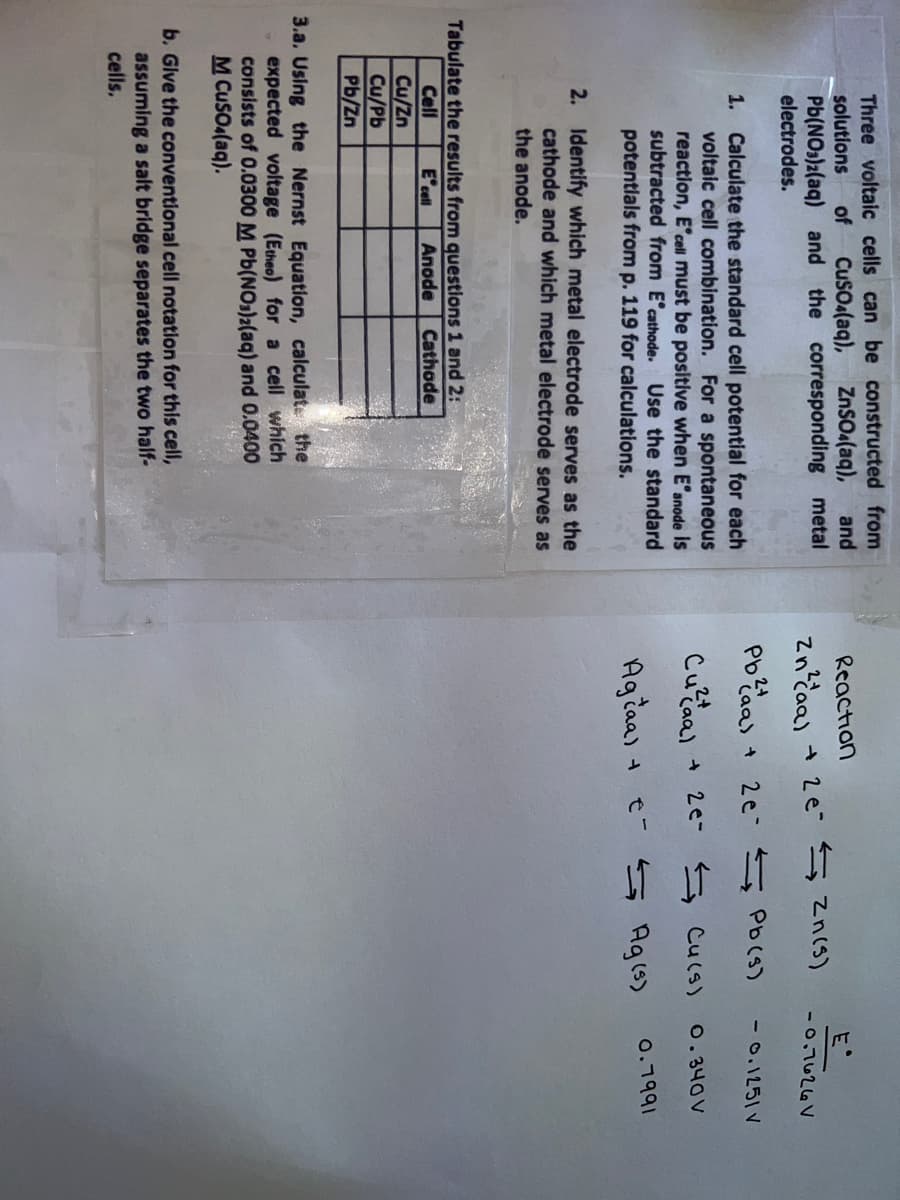Three voltaic cells can be constructed from solutions of Cusoa(aq), ZnSOa(aq), and Reaction E Pb(NOs)2(aq) and the corresponding metal electrodes. Znaa) + 2e" s zn(s) - 0. 24 Pbaa) + 2e 5 Pb(s) 1. Calculate the standard cell potential for each voltaic cell combination. For a spontaneous reaction, E'cell must be positive when E'anode is subtracted from E'cathode. Use the standard potentlals from p. 119 for calculations. + 2e- ら Cu(s) Agiaa) + t- S Ag(s) 2. Identify which metal electrode serves as the cathode and which metal electrode serves as the anode. Tabulate the results from questions 1 and 2: Cathode Cell E'cll Anode Cu/Zn Cu/Pb Pb/Zn 3.a. Using the Nernst Equation, calculate the expected voltage (Etheo) for a cell which consists of 0.0300 M Pb(NO)z(aq) and 0.0400 M CuSO(aq). b. Glve the conventional cell notation for this cell, assuming a salt bridge separates the two half- cells.
Three voltaic cells can be constructed from solutions of Cusoa(aq), ZnSOa(aq), and Reaction E Pb(NOs)2(aq) and the corresponding metal electrodes. Znaa) + 2e" s zn(s) - 0. 24 Pbaa) + 2e 5 Pb(s) 1. Calculate the standard cell potential for each voltaic cell combination. For a spontaneous reaction, E'cell must be positive when E'anode is subtracted from E'cathode. Use the standard potentlals from p. 119 for calculations. + 2e- ら Cu(s) Agiaa) + t- S Ag(s) 2. Identify which metal electrode serves as the cathode and which metal electrode serves as the anode. Tabulate the results from questions 1 and 2: Cathode Cell E'cll Anode Cu/Zn Cu/Pb Pb/Zn 3.a. Using the Nernst Equation, calculate the expected voltage (Etheo) for a cell which consists of 0.0300 M Pb(NO)z(aq) and 0.0400 M CuSO(aq). b. Glve the conventional cell notation for this cell, assuming a salt bridge separates the two half- cells.
Principles of Modern Chemistry
8th Edition
ISBN:9781305079113
Author:David W. Oxtoby, H. Pat Gillis, Laurie J. Butler
Publisher:David W. Oxtoby, H. Pat Gillis, Laurie J. Butler
Chapter17: Electrochemistry
Section: Chapter Questions
Problem 77AP
Related questions
Question

Transcribed Image Text:Three voltaic cells can be constructed from
solutions
Pb(NO3)2(aq) and the corresponding metal
electrodes.
of
Cuso (aq),
ZnSOa(aq),
and
Reaction
E
Zn?daa) + 2e s zn(s)
-0,7626V
Pbaas +
2e 5 Pb (S)
- 0.1251 V
Calculate the standard cell potential for each
voltaic cell combination. For a spontaneous
reaction, E'cell must be positive when E'anode is
subtracted from E'cathode. Use the standard
potentlals from p. 119 for calculations.
1.
* 2e- ニ Cucs)
0. 340 V
Agčaa)
e- 5 Ag(s)
0.7991
2. Identify which metal electrode serves as the
cathode and which metal electrode serves as
the anode.
Tabulate the results from questions 1 and 2:
E'cell
Cell
Anode
Cathode
Cu/Zn
Cu/Pb
Pb/Zn
3.a. Using the Nernst Equation, calculate the
expected voltage (Etheo) for a cell which
consists of 0.0300 M Pb(NOs)2(aq) and 0.0400
M CuSO (aq).
b. Glve the conventional cell notation for this cell,
assuming a salt bridge separates the two half-
cells.
Expert Solution
This question has been solved!
Explore an expertly crafted, step-by-step solution for a thorough understanding of key concepts.
This is a popular solution!
Trending now
This is a popular solution!
Step by step
Solved in 3 steps with 3 images

Knowledge Booster
Learn more about
Need a deep-dive on the concept behind this application? Look no further. Learn more about this topic, chemistry and related others by exploring similar questions and additional content below.Recommended textbooks for you

Principles of Modern Chemistry
Chemistry
ISBN:
9781305079113
Author:
David W. Oxtoby, H. Pat Gillis, Laurie J. Butler
Publisher:
Cengage Learning

Chemistry: The Molecular Science
Chemistry
ISBN:
9781285199047
Author:
John W. Moore, Conrad L. Stanitski
Publisher:
Cengage Learning

Principles of Instrumental Analysis
Chemistry
ISBN:
9781305577213
Author:
Douglas A. Skoog, F. James Holler, Stanley R. Crouch
Publisher:
Cengage Learning

Principles of Modern Chemistry
Chemistry
ISBN:
9781305079113
Author:
David W. Oxtoby, H. Pat Gillis, Laurie J. Butler
Publisher:
Cengage Learning

Chemistry: The Molecular Science
Chemistry
ISBN:
9781285199047
Author:
John W. Moore, Conrad L. Stanitski
Publisher:
Cengage Learning

Principles of Instrumental Analysis
Chemistry
ISBN:
9781305577213
Author:
Douglas A. Skoog, F. James Holler, Stanley R. Crouch
Publisher:
Cengage Learning

Chemistry: Principles and Practice
Chemistry
ISBN:
9780534420123
Author:
Daniel L. Reger, Scott R. Goode, David W. Ball, Edward Mercer
Publisher:
Cengage Learning

Chemistry
Chemistry
ISBN:
9781305957404
Author:
Steven S. Zumdahl, Susan A. Zumdahl, Donald J. DeCoste
Publisher:
Cengage Learning
